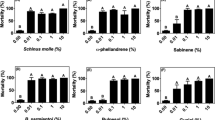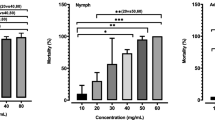Abstract
Rhipicephalus sanguineus sensu lato (s.l.), also known as the brown dog tick, is among the main tick species involved in the transmission of pathogens to humans and other animals and, therefore, the target of numerous control methods. However, due to the disadvantages of synthetic acaricides, the use of alternative products such as plant derivatives has been encouraged. This study aimed to evaluate the acaricidal potential of acetylcarvacrol and to determine its efficacy at sublethal doses for the control of R. sanguineus s.l. female ticks. In addition, as acetylcarvacrol was applied topically, morphological alterations in the integument were assessed. Acetylation of carvacrol was performed by reaction with acetic anhydride in a sodium hydroxide solution, being confirmed by infrared spectroscopy. The lethal concentration for 50 and 90% (LC50 and LC90) of unfed ticks and the efficacy of acetylcarvacrol in engorged females were determined after the Adult Immersion Test (AIT). For the evaluation of effects of acetylcarvacrol in the integument, routine histological techniques were employed after the AIT. The LC50 and LC90 in unfed females were 2.8 and 7.2 μL/mL, respectively. Regarding reproductive performance, after treatment with 8.0 μL/mL acetylcarvacrol 90.9% control was achieved, as ticks showed the lowest egg production index (EPI), hatching rate (HR), and fecundity rate (FR). In the integument, considerable morphological alterations were observed both in cuticle and epithelium. Thus, acetylcarvacrol affected R. sanguineus s.l. external coating and reproduction when applied at sublethal concentrations, probably contributing to a long-term control.


Similar content being viewed by others
References
Alves WV, Lorenzetti ER, Gonçalves FC (2012) Utilização de acaricidas a base de plantas no controle de Rhipicephalus (Boophilus) microplus: uma contribuição para a produção e desenvolvimento sustentável. Rev Bras Agropecu Sustent 2(2):14–25. https://doi.org/10.21206/rbas.v2i2.162
Andre WPP, Ribeiro WLC, Cavalcante GS, Santos JML, Macedo ITF, Paula HCB, Freitas RM, Morais SM, Melo JV, Bevilaqua CML (2016) Comparative efficacy and toxic effects of carvacryl acetate and carvacrol on sheep gastrointestinal nematodes and mice. Vet Parasitol 218:52–58. https://doi.org/10.1016/j.vetpar.2016.01.001
Araújo LX, Novato TPL, Zeringota V, Maturano R, Melo D, Silva BC, Daemon E, Carvalho MG, Monteiro CMO (2016) Synergism of thymol, carvacrol and eugenol in larvae of the cattle tick, Rhipicephalus microplus, and brown dog tick, Rhipicephalus sanguineus. Med Vet Entomol 30:377–382. https://doi.org/10.1111/mve.12181
Bandara KMUJ, Karunaratne SHPP (2017) Mechanisms of acaricide resistance in the cattle tick Rhipicephalus (Boophilus) microplus in Sri Lanka. Pestic Biochem Phys 139:68–72. https://doi.org/10.1016/j.pestbp.2017.05.002
Bechara GH, Szabó MPJ, Ferreira BR, Garcia MV (1995) Rhipicephalus sanguineus tick in Brazil: feeding and reproductive aspects under laboratorial conditions. Braz J Vet Parasitol 4:61–66
Ben Arfa A, Combes S, Preziosi-Belloy L, Gontard N, Chalier P (2006) Antimicrobial activity of carvacrol related to its chemical structure. Lett Appl Microbiol 43:149–154. https://doi.org/10.1111/j.1472-765X.2006.01938.x
Borges LMF, Sousa LAD, Barbosa CS (2011) Perspectives for the use of plant extracts to control the cattle tick Rhipicephalus (Boophilus) microplus. Rev Bras Parasitol Vet 20:89. https://doi.org/10.1590/S1984-29612011000200001
Camargo-Mathias MI (2018) Inside ticks: morphophysiology, toxicology and therapeutic perspectives, vol 1. Editora Unesp, São Paulo
Carpenter TL, McMeans C, McHugh CP (1989) Additional Instances of Human Parasitism by the Brown Dog Tick Rhipicephalus sanguineus. J Med Entomol 27(6):1065–1066. https://doi.org/10.21236/ADA218723
Castro-Janer E, Rifran L, Piaggio J, Gil A, Miller RJ, Schumaker TTS (2009) In vitro tests to establish LC50 and discriminating concentrations for fipronil against Rhipicephalus (Boophilus) microplus (Acari: Ixodidae) and their standardization. Vet Parasitol 162:120–128. https://doi.org/10.1016/j.vetpar.2009.02.013
Coons LB, Alberti G (1999) Acari: Ticks. In: Harrison FW, Foelix R (eds) Miroscopic Anatomy of Invertebrates, vol 8b. Wiley-Liss, New York, pp 267–514
Coskun S, Girisgin O, Kürkcüoglu M, Malyer H, Girisgin A, Kırımer N, Baser K (2008) Acaricidal efficacy of Origanum onites L. essential oil against Rhipicephalus turanicus (Ixodidae). Parasitol Res 103:259–261. https://doi.org/10.1007/s00436-008-0956-x
Cruz EMO, Costa-Junior LM, Pinto JAO, Santos DA, Araujo SA, Arrigoni-Blank MF, Bacci L, Alves PB, Cavalcanti SCH, Blank AF (2013) Acaricidal activity of Lippia gracilis essential oil and its major constituents on the tick Rhipicephalus (Boophilus) microplus. Vet Parasitol 195:198–202. https://doi.org/10.1016/j.vetpar.2012.12.046
Cunha NC, Fonseca AH, Rezende J, Rozental T, Favacho ARM, Barreira JD, Massard CL, Lemos ERS (2009) First identification of natural infection of Rickettsia rickettsii in the Rhipicephalus sanguineus tick, in the State of Rio de Janeiro. Pesqui Vet Bras 29:105–108. https://doi.org/10.1590/S0100-736X2009000200003
Dantas-Torres F (2008) The brown dog tick, Rhipicephalus sanguineus (Latreille, 1806) (Acari: Ixodidae): From taxonomy to control. Vet Parasitol 152:173–185. https://doi.org/10.1016/j.vetpar.2007.12.030
Dantas-Torres F (2010) Biology and ecology of the brown dog tick Rhipicephalus sanguineus. Parasite Vector 3:26. https://doi.org/10.1186/1756-3305-3-26
Dantas-Torres F, Otranto D (2015) Further thoughts on the taxonomy and vector role of Rhipicephalus sanguineus group ticks. Vet Parasitol 208:9–13. https://doi.org/10.1016/j.vetpar.2014.12.014
Damasceno SRB, Oliveira FRAM, Carvalho NS, Brito CFC, Silva IS, Sousa FBM, Silva RO, Sousa DP, Barbosa ALR, Freitas RM, Medeiros JR (2014) Carvacryl acetate, a derivative of carvacrol, reduces nociceptive and inflammatory response in mice. Life Sci 94:58–66. https://doi.org/10.1016/j.lfs.2013.11.001
Drummond RO, Ernst SE, Trevino JL, Gladney WJ, Graham OH (1973) Boophilus annulatus and B. microplus: laboratory tests of insecticides. J Econ Entomol 66:130–133. https://doi.org/10.1093/jee/66.1.130
Furlong J, Martins JR, Prata MCA (2007) O carrapato dos bovinos e a resistência: temos o que comemorar? A Hora Veterinária 27:26–32
Gomes GA, Monteiro C, Senra T, Zeringota V, Calmon F, Matos R, Daemon E, Gois R, Santiago G, Carvalho M (2012) Chemical composition and acaricidal activity of essential oil from Lippia sidoides on larvae of Dermacentor nitens (Acari: Ixodidae) and larvae and engorged females of Rhipicephalus microplus (Acari: Ixodidae). Parasitol Res 111:2423–2430. https://doi.org/10.1007/s00436-012-3101-9
Gonçalves RRP, Peconick AP, Thomasi SS, Konig IFM, Gomes SL, Remedio RN (2019) Acaricidal activity and effects of acetylcarvacrol on Rhipicephalus (Boophilus) microplus (Canestrini, 1888) engorged female ticks (Acari: Ixodidae). Int J Acarol 45:404–408. https://doi.org/10.1080/01647954.2019.1665100
Hackman RH (1982) Structure and function in tick cuticle. Annu Rev Entomol 27:75
Harrison BA, Engber BR, Apperson CS (1997) Ticks (Acari: Ixodida) uncommonly found biting humans in North Carolina. J Vector Ecol 22(1):6–12
Higa LOS, Garcia MV, Barros JC, Koller WW, Andreotti R (2016) Evaluation of Rhipicephalus (Boophilus) microplus (Acari: Ixodidae) resistance to different acaricide formulations using samples from Brazilian properties. Rev Bras Parasitol Vet. https://doi.org/10.1590/S1984-29612016026
Koc S, Oz E, Cinbilgel I, Aydin L, Cetin H (2013) Acaricidal activity of Origanum bilgeri P.H. Davis (Lamiaceae) essential oil and its major component, carvacrol against adults Rhipicephalus turanicus (Acari: Ixodidae). Vet Parasitol 193:316–319. https://doi.org/10.1016/j.vetpar.2012.11.010
Konig IFM, Gonçalves RRP, Oliveira MVS, Silva CM, Thomasi SS, Peconick AP, Remedio RN (2019) Sublethal concentrations of acetylcarvacrol strongly impact oocyte development of engorged female cattle ticks Rhipicephalus microplus (Canestrini, 1888) (Acari: Ixodidae). Ticks Tick-Borne Dis 10:766–774. https://doi.org/10.1016/j.ttbdis.2019.03.010
Konig IFM, Oliveira MVS, Gonçalves RRP, Peconick AP, Thomasi SS, Anholeto LA, Lima-de-Souza JR, Camargo-Mathias MI, Remedio RN (2020) Low concentrations of acetylcarvacrol induce drastic morphological damages in ovaries of surviving Rhipicephalus sanguineus sensu lato ticks (Acari: Ixodidae). Micron 129:102780. https://doi.org/10.1016/j.micron.2019.102780
Kulisic T, Radonic A, Katalinic V, Milos M (2004) Use of different methods for testing antioxidative activity of oregano essential oil. Food Chem 85:633–640. https://doi.org/10.1016/j.foodchem.2003.07.024
Lage TCA, Montanari RM, Fernandes SA, Monteiro CMO, Senra TOS, Zeringota V, Calmon F, Matos RS, Daemon E (2013) Activity of essential oil of Lippia triplinervis Gardner (Verbenaceae) on Rhipicephalus microplus (Acari: Ixodidae). Parasitol Res 112:863–869. https://doi.org/10.1007/s00436-012-3209-y
Lima de Souza JR, Remedio RN, Arnosti A, de Abreu RMM, Camargo-Mathias MI (2017) The effects of neem oil (Azadirachta indica A JUSS) enriched with different concentrations of azadirachtin on the integument of semi-engorged Rhipicephalus sanguineus sensu lato (Acari: Ixodidae) females. Microsc Res Techniq 80:838. https://doi.org/10.1002/jemt.22871
Lima de Souza JR, Oliveira PR, Anholeto LA, Arnosti A, Daemon E, Remedio RN, Camargo-Mathias MI (2019) Effects of carvacrol on oocyte development in semi-engorged Rhipicephalus sanguineus sensu lato females ticks (Acari: Ixodidae). Micron 116:66–72. https://doi.org/10.1016/j.micron.2018.09.015
Lopes WDZ, Teixeira WFP, Matos LVS, Felippelli G, Cruz BC, Maciel WG, Buzzulini C, Fávero FC, Soares VE, Oliveira GP, Costa AJ (2013) Effects of macrocyclic lactones on the reproductive parameters of engorged Rhipicephalus (Boophilus) microplus females detached from experimentally infested cattle. Exp Parasitol 135:72–78. https://doi.org/10.1016/j.exppara.2013.06.003
Manfredi MT, Dini V, Piacenza S, Genchi C (1999) Tick species parasitizing people in an area endemic for tick-borne diseases in north-western Italy. Parassitologia 41:555–560
Matos RS, Melo DR, Monteiro CMO, Zeringota V, Senra TOS, Calmon F, Maturano R, Prata MCA, Daemon E (2014) Determination of the susceptibility of unengorged larvae and engorged females of Rhipicephalus microplus (Acari: Ixodidae) to different methods of dissolving thymol. Parasitol Res 113:669. https://doi.org/10.1007/s00436-013-3694-7
Monteiro CO, Daemon E, Clemente MA, Rosa LS, Maturano R (2009) Acaricidal efficacy of thymol on engorged nymphs and females of Rhipicephalus sanguineus (Latreille, 1808) (Acari: Ixodidae). Parasitol Res 105:1093–1097. https://doi.org/10.1007/s00436-009-1530-x
Oliveira PR, Bechara GH, Camargo-Mathias MI (2008) Evaluation of cytotoxic effects of fipronil on ovaries of semi-engorged Rhipicephalus sanguineus (Latreille, 1806) (Acari: Ixodidae) tick female. Food Chem Toxicol 46:2459–2465. https://doi.org/10.1016/j.fct.2008.03.034
Pereira Junior AM, Camargo-Mathias MI, Daemon E, Peconick AP, Lima-Souza JR, Oliveira PR, Braga AS, Lara LJ, Remedio RN (2019) Efficacy of carvacrol on Rhipicephalus (Boophilus) microplus engorged female ticks (Canestrini, 1887) (Acari: Ixodidae): effects on mortality and reproduction. Nat Prod Res Article in Press. https://doi.org/10.1080/14786419.2019.1569657
Prado-Ochoa MG, Muñoz-Guzmán MA, Abrego-Reyes VH, Velázquez-Sánchez AM, Lara-Rocha M, Cuenca-Verde C, Angeles E, Alba-Hurtado F (2013) Effect of new ethyl and methyl carbamates on biological parameters and reproduction of the cattle tick Rhipicephalus microplus. Vet Parasitol 194:49–57. https://doi.org/10.1016/j.vetpar.2012.12.026
Ramírez C, Ibarra F, Pérez HI, Manjarrez N, Salgado HJ, Ortega L (2016) Assessment and determination of LC50 of carvacrol and salicylic acid analogues with acaricide activity in larvae and adult ticks of Rhipicephalus (Boophilus) microplus. Parasite Epidemiol Control 1:72–77. https://doi.org/10.1016/j.parepi.2016.02.006
Remedio RN, Nunes PH, Anholeto LA, Camargo-Mathias MI (2014) Morphological alterations in the synganglion and integument of Rhipicephalus sanguineus ticks exposed to aqueous extracts of neem leaves (Azadirachta indica A. JUSS). Microsc Res Techniq 77:989–998. https://doi.org/10.1002/jemt.22427
Remedio RN, Nunes PH, Camargo-Mathias MI (2015) The extensible integument of Rhipicephalus sanguineus female ticks in different feeding stages: a morphological approach. Acta Zool 96:319–327. https://doi.org/10.1111/azo.12079
Roma GC, Oliveira PR, Pizano MA, Camargo-Mathias MI (2009) Determination of LC50 of permethrin acaricide in semi-engorged females of the tick Rhipicephalus sanguineus (Latreille, 1806) (Acari: Ixodidae). Exp Parasitol 123:269–272
Solomons TWG, Fryhle CB, Snyder SA (2016) Organic Chemistry, 12th edn. John Wiley, Hoboken
Troughton DR, Levin ML (2007) Llife cycles of seven ixodid tick species (Acari: Ixodidae) under standardized laboratory conditions. J Med Entomol 44(5):732–740. https://doi.org/10.1093/jmedent/44.5.732
Walker AR, Lloyd CM, McGuire K, Harrison SJ, Hamilton JG (1996) Integumental glands of the tick Rhipicephalus appendiculatus (Acari: Ixodidae) as potential producers of semiochemicals. J Med Entomol 33:743–759. https://doi.org/10.1093/jmedent/33.5.743
Wang J, Maharana S, Wang MD, Shivashankar GV (2014) Super-resolution microscopy reveals decondensed chromatin structure at transcription sites. Sci Rep 4:4477. https://doi.org/10.1038/srep04477
Acknowledgements
This research was financially supported by Coordenação de Aperfeiçoamento de Pessoal de Nível Superior (CAPES, Brazil) and Conselho Nacional de Desenvolvimento Científico e Tecnológico (CNPq, Brazil, Grant Number 430327/2018-8).
Funding
Coordenação de Aperfeiçoamento de Pessoal de Nível Superior (CAPES, Brazil) and Conselho Nacional de Desenvolvimento Científico e Tecnológico (CNPq, Brazil, Grant number 430327/2018–8).
Author information
Authors and Affiliations
Corresponding author
Ethics declarations
Conflict of interest
No conflicts of interest to declare.
Additional information
Publisher's Note
Springer Nature remains neutral with regard to jurisdictional claims in published maps and institutional affiliations.
Rights and permissions
About this article
Cite this article
de Oliveira, M.V.S., Konig, I.F.M., Reis, A.C. et al. Sublethal concentrations of acetylcarvacrol affect reproduction and integument morphology in the brown dog tick Rhipicephalus sanguineus sensu lato (Acari: Ixodidae). Exp Appl Acarol 82, 265–279 (2020). https://doi.org/10.1007/s10493-020-00538-7
Received:
Accepted:
Published:
Issue Date:
DOI: https://doi.org/10.1007/s10493-020-00538-7




